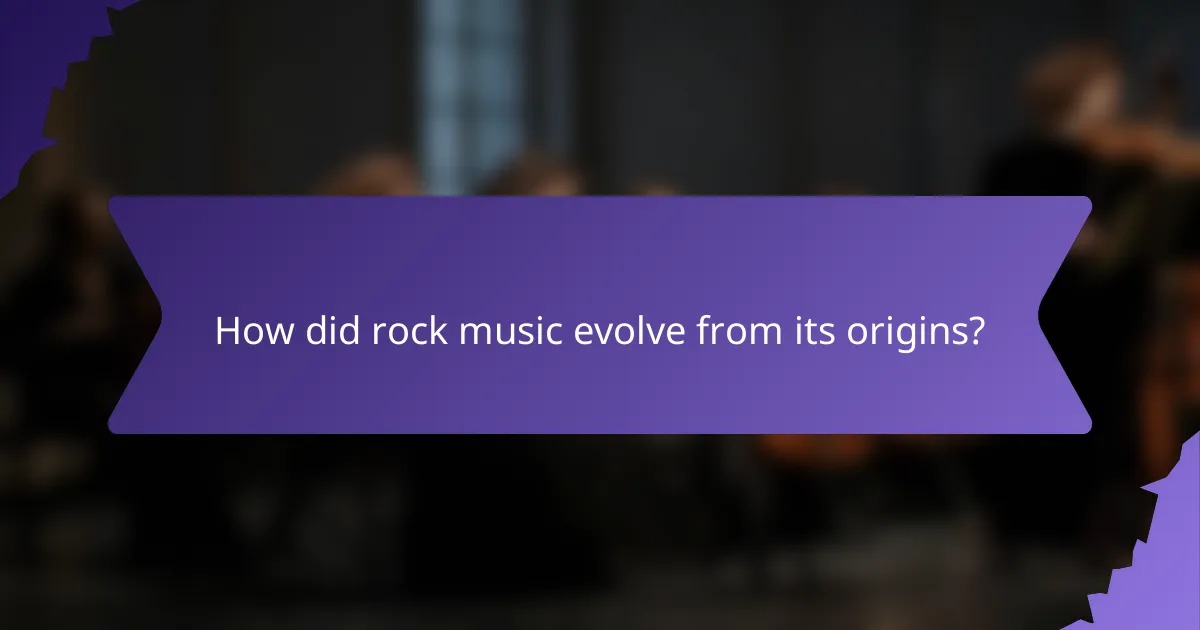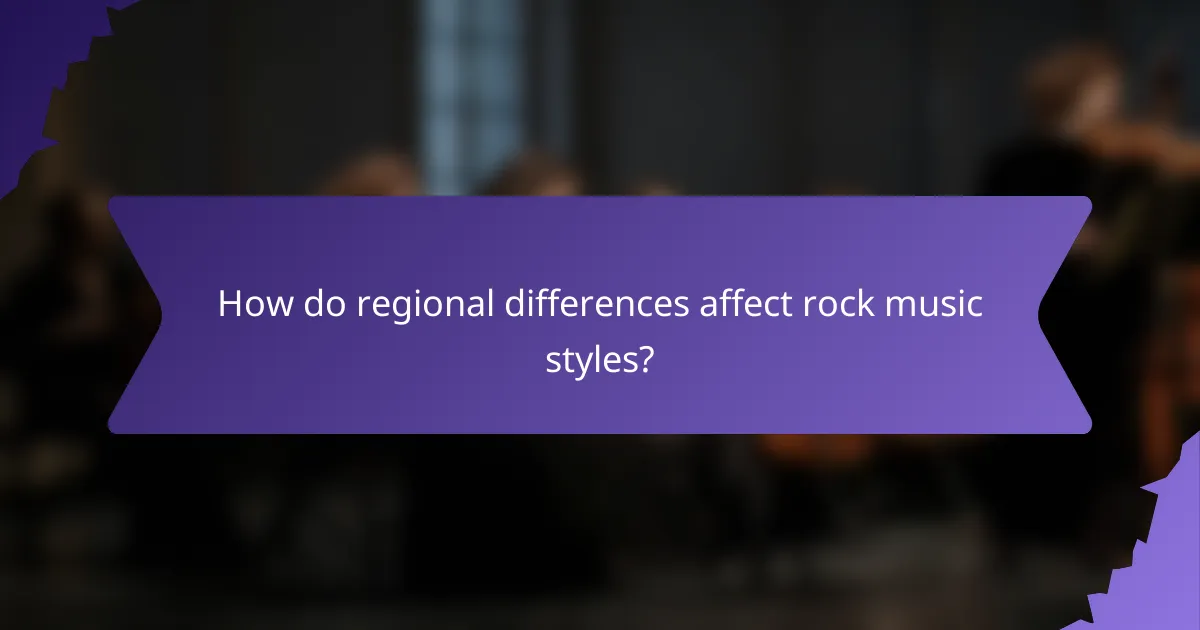Rock music has shaped cultural landscapes and social movements since its emergence in the 1940s. This article explores its development, major subgenres, and lasting cultural significance. Key influences include the integration of electric instruments and the rise of diverse styles like punk and metal. Additionally, rock’s role in advocating for social change and its regional variations highlight its rich and evolving legacy.

How did rock music evolve from its origins?
Rock music evolved from its origins in the 1940s and 1950s, influenced by rhythm and blues, country, and jazz. Key developments include the integration of electric instruments, the rise of subgenres like punk and metal, and its cultural significance in social movements. The genre’s adaptability has allowed it to reflect societal changes, making it a powerful medium for expression. Unique attributes of rock include its emphasis on live performances and the iconic status of various artists, which have shaped its enduring legacy.
What cultural influences shaped early rock music?
Early rock music was shaped by various cultural influences, including rhythm and blues, country, and folk music. The blending of African American musical traditions with white American styles created a unique sound. Artists like Chuck Berry and Elvis Presley played pivotal roles in this fusion. The social changes of the 1950s, including youth culture and racial integration, further propelled rock music’s evolution. Additionally, the rise of radio and television helped popularize rock, making it a significant cultural force.
Which key figures contributed to the rise of rock music?
Key figures such as Chuck Berry, Elvis Presley, and The Beatles significantly contributed to the rise of rock music. Chuck Berry pioneered guitar-driven rock and roll with hits like “Johnny B. Goode.” Elvis Presley blended various genres, bringing rock into mainstream culture. The Beatles revolutionized music with innovative songwriting and studio techniques, influencing countless artists. These figures shaped rock music’s development, subgenres, and cultural significance, establishing a lasting legacy.
How did technological advancements impact rock music development?
Technological advancements significantly shaped rock music development by influencing sound, production, and distribution. Innovations like electric guitars and amplifiers transformed the genre’s sound, enabling louder and more complex compositions. The introduction of multitrack recording allowed artists to layer sounds, enhancing creativity and production quality. Digital technology revolutionized music distribution, making it easier for artists to reach global audiences. Streaming platforms further altered consumption patterns, shifting how fans engage with rock music. These advancements collectively expanded the genre’s boundaries and cultural impact.

What are the major subgenres of rock music?
Rock music encompasses various major subgenres, including classic rock, punk rock, metal, alternative rock, indie rock, and hard rock. Each subgenre has distinct characteristics and cultural influences. Classic rock, rooted in the 1960s and 1970s, is known for its anthemic sound and guitar solos. Punk rock emerged in the 1970s as a reaction against mainstream music, emphasizing simplicity and raw energy. Metal evolved from rock, featuring heavier instrumentation and themes. Alternative rock gained prominence in the 1980s and 1990s, often blending various styles and challenging norms. Indie rock represents a more DIY approach, focusing on independent production and unique sounds. Hard rock is characterized by its aggressive sound and powerful vocals. These subgenres reflect the evolution of rock music and its impact on culture and society.
How does classic rock differ from modern rock?
Classic rock features a vintage sound and instrumentation, while modern rock incorporates diverse influences and technological advancements. Classic rock often emphasizes guitar riffs and lyrical storytelling, whereas modern rock experiments with genres like electronic and pop. Additionally, classic rock draws heavily from the 1960s to 1980s, while modern rock spans the late 1990s to present, reflecting cultural shifts and evolving musical trends.
What defines punk rock and its cultural significance?
Punk rock is defined by its raw sound, anti-establishment ethos, and cultural impact. Emerging in the 1970s, it challenged mainstream music and societal norms, promoting individuality and rebellion. Punk’s cultural significance lies in its influence on fashion, art, and political movements, fostering a sense of community among its followers. The genre’s unique attributes include its DIY approach and emphasis on authenticity, which continue to inspire new generations of artists and activists.
Which characteristics distinguish alternative rock from other subgenres?
Alternative rock is distinguished by its eclectic sound, lyrical depth, and rejection of mainstream conventions. It often incorporates diverse influences, blending elements from genres like punk, jazz, and folk. Unique attributes include a focus on personal and political themes, often reflecting social issues. The instrumentation varies widely, utilizing unconventional sounds and production techniques, setting it apart from more commercial rock subgenres.

How has rock music influenced social movements?
Rock music has significantly influenced social movements by providing a voice for change and resistance. Its roots in rebellion and counterculture have empowered artists to address social issues. For example, the anti-war movement in the 1960s utilized rock music to protest against the Vietnam War, with songs like “Fortunate Son” by Creedence Clearwater Revival becoming anthems of dissent.
Additionally, rock music’s diverse subgenres have addressed various social issues, such as civil rights, gender equality, and environmentalism. Artists like Bob Dylan and Joan Baez used their platforms to advocate for civil rights, while punk rock bands in the 1970s challenged societal norms and political corruption.
The unique attribute of rock music lies in its ability to unite diverse audiences around shared values and causes. This cultural significance continues today, as modern rock artists engage with contemporary social issues, demonstrating the genre’s lasting impact on social movements.
What role did rock music play in the counterculture of the 1960s?
Rock music played a pivotal role in the counterculture of the 1960s by embodying rebellion and social change. It served as a voice for youth disillusioned with mainstream values, promoting freedom, peace, and civil rights. Iconic festivals like Woodstock showcased this cultural shift, uniting diverse groups through music. Artists like Bob Dylan and The Beatles challenged societal norms, influencing political movements and advocating for change. The unique attribute of rock music during this era was its ability to unify and inspire a generation, making it a powerful tool for expressing dissent and hope.
How do rock anthems reflect societal issues?
Rock anthems often mirror societal issues by addressing themes like inequality, war, and personal freedom. These songs resonate with listeners, reflecting collective frustrations and aspirations. For instance, tracks from the 1960s and 1970s, like “Fortunate Son” by Creedence Clearwater Revival, critique class disparity and the Vietnam War. Similarly, contemporary anthems continue to spotlight social justice, echoing movements like Black Lives Matter. This cultural significance illustrates rock music’s role as a voice for change, uniting generations through shared experiences and challenges.

What are the unique attributes of specific rock music scenes?
Unique attributes of specific rock music scenes include distinct sounds, cultural influences, and regional characteristics. For example, the Seattle grunge scene is marked by its raw, heavy sound and anti-establishment ethos, while the British punk scene is defined by its fast tempos and political themes. The California surf rock scene features upbeat melodies and themes of beach culture. Each scene not only reflects musical innovation but also embodies the social and political contexts of its time.
How did the Seattle grunge scene redefine rock music in the 1990s?
The Seattle grunge scene transformed rock music in the 1990s by blending punk, metal, and alternative styles. This fusion created a raw, authentic sound that emphasized emotional expression. Key bands like Nirvana and Pearl Jam popularized this genre, leading to widespread cultural influence. The scene challenged mainstream music norms, promoting themes of disillusionment and social commentary. As a result, grunge not only reshaped rock but also impacted fashion and youth culture, marking a significant shift in the music landscape.
What makes the British Invasion significant in rock history?
The British Invasion significantly transformed rock history by introducing British bands to the American music scene. This movement, primarily in the 1960s, showcased iconic groups like The Beatles and The Rolling Stones, influencing countless artists globally. The British Invasion revitalized rock music, blending various genres and encouraging cultural exchanges. It marked a shift in musical authority from the United States to the United Kingdom, reshaping popular music’s landscape. Additionally, it sparked new subgenres and inspired the counterculture movement, highlighting the era’s social and artistic dynamism.

Which rare rock music collaborations have made an impact?
Several rare rock music collaborations have significantly impacted the genre. One notable example is the collaboration between David Bowie and Queen on “Under Pressure,” which blended rock with a unique sound. Another impactful partnership was between Aerosmith and Run-D.M.C. for “Walk This Way,” merging rock and hip-hop. Additionally, the supergroup Traveling Wilburys, featuring Bob Dylan, Tom Petty, and George Harrison, showcased the power of collaboration across different rock styles. These collaborations not only pushed genre boundaries but also influenced future artists and trends in rock music.
What notable supergroups have emerged in rock music?
Notable supergroups in rock music include Cream, The Traveling Wilburys, Audioslave, and Them Crooked Vultures. These groups feature renowned musicians from various bands, creating unique sounds and collaborations.
Cream, formed in 1966, combined Eric Clapton, Jack Bruce, and Ginger Baker, pioneering blues rock. The Traveling Wilburys emerged in the late 1980s, featuring Bob Dylan, George Harrison, Jeff Lynne, Roy Orbison, and Tom Petty, blending rock and folk influences. Audioslave, formed in 2001, united members of Rage Against the Machine and Soundgarden, producing a fusion of hard rock and alternative metal. Them Crooked Vultures, which includes Josh Homme, Dave Grohl, and John Paul Jones, showcases a blend of stoner rock and hard rock elements.
These supergroups demonstrate the versatility and collaborative spirit within rock music, enriching its cultural significance.
How have cross-genre collaborations influenced rock music?
Cross-genre collaborations have significantly expanded rock music’s sound and cultural reach. These collaborations blend diverse musical elements, creating innovative subgenres and attracting wider audiences. For instance, rock artists have incorporated hip-hop, electronic, and country influences, leading to unique fusions like rap-rock and country-rock. This evolution has fostered collaborations between artists like Linkin Park and Jay-Z, showcasing how cross-genre partnerships can enhance creativity and appeal. As a result, rock music continues to evolve, reflecting broader cultural trends and musical experimentation.

What are the enduring themes found in rock music lyrics?
Enduring themes in rock music lyrics include rebellion, love, social issues, and personal struggle. These themes resonate across generations, reflecting cultural and emotional experiences. Rebellion often critiques authority, while love explores relationships’ complexities. Social issues address topics like war and inequality, and personal struggle reveals vulnerability and resilience. Together, these themes contribute to rock music’s cultural significance and enduring appeal.
How do rock lyrics address personal struggles and triumphs?
Rock lyrics often reflect personal struggles and triumphs through raw emotion and storytelling. They address themes like heartbreak, addiction, and resilience, allowing listeners to connect deeply. Iconic songs often serve as anthems for overcoming adversity, showcasing the transformative power of music. This connection resonates universally, making rock a significant cultural force in expressing the human experience.
What recurring motifs can be identified in rock music?
Recurring motifs in rock music include themes of rebellion, love, and social commentary. These motifs reflect cultural and emotional experiences prevalent in society. For example, rebellion often manifests through lyrics that challenge authority or societal norms. Love songs frequently explore relationships and heartache, while social commentary addresses issues like politics and inequality. The use of electric guitars and strong rhythms further enhances these motifs, creating an impactful sound that resonates with listeners.

How do regional differences affect rock music styles?
Regional differences significantly shape rock music styles through cultural influences and local traditions. For instance, the British Invasion introduced a distinct sound characterized by melodic elements and lyrical storytelling. In contrast, American rock often incorporates blues and folk influences, resulting in a rawer, more emotive style.
Geographical factors also affect instrumentation and production techniques. For example, surf rock from California utilizes reverb-heavy guitars, while grunge from Seattle features a heavier, distorted sound. These regional characteristics contribute to the diversity of rock music, reflecting the unique cultural landscapes from which they emerge.
Additionally, social and political contexts influence lyrical themes. For instance, punk rock in the UK emerged as a response to economic hardship, while American punk often focuses on personal freedom and rebellion. This interplay of regional differences creates a rich tapestry of rock music that evolves continuously.
What are the defining characteristics of rock music in different cultures?
Rock music varies significantly across cultures, shaped by local influences and traditions. In the United States, rock emerged as a fusion of blues and country, focusing on themes of rebellion and youth. British rock introduced elements of experimentation and lyrical sophistication, exemplified by bands like The Beatles and The Rolling Stones. In Latin America, rock often incorporates indigenous rhythms, creating unique subgenres like rock en español, which reflects social and political issues. Meanwhile, Asian rock scenes, such as Japanese rock, blend Western styles with local musical elements, resulting in diverse sounds and cultural expressions. Each culture’s rock music serves as a mirror, reflecting societal values and historical contexts.
How have local music festivals shaped regional rock scenes?
Local music festivals have significantly influenced regional rock scenes by fostering community engagement and showcasing local talent. These events create platforms for emerging artists, allowing them to gain exposure and connect with audiences. Festivals often feature diverse subgenres, reflecting regional musical tastes and encouraging collaboration among musicians.
Additionally, festivals can drive tourism and local economies, attracting visitors who support local businesses. They often serve as cultural hubs, preserving and promoting the unique identity of rock music within the region. As a result, the impact of local music festivals extends beyond entertainment, shaping the cultural landscape and nurturing the growth of rock music in various communities.

What are the best practices for engaging with rock music today?
To engage with rock music today, focus on authenticity, community involvement, and embracing digital platforms. Authenticity resonates with audiences; artists should express genuine emotions and experiences. Community engagement fosters loyalty; attend local shows and participate in fan events. Digital platforms, such as social media and streaming services, are essential for reaching wider audiences and sharing music. Additionally, explore diverse subgenres to connect with various listener demographics, enhancing cultural significance and relevance in modern music scenes.
How can fans support emerging rock artists effectively?
Fans can support emerging rock artists effectively by engaging with their music, attending shows, and promoting them on social media. Active listening on streaming platforms increases visibility and generates revenue. Purchasing merchandise directly from artists fosters financial support and builds community. Collaborating with local venues for live performances creates opportunities for exposure. Lastly, providing constructive feedback helps artists grow and refine their craft.
What common mistakes should listeners avoid when exploring rock music?
Listeners should avoid superficial judgments and stereotypes when exploring rock music. Engaging deeply with the genre’s diversity enhances appreciation. One common mistake is ignoring subgenres like punk or metal, which offer unique attributes and cultural significance. Another is overlooking historical context; understanding rock’s evolution reveals its impact on society. Lastly, dismissing lesser-known artists limits exposure to innovative sounds and ideas within the rock landscape.